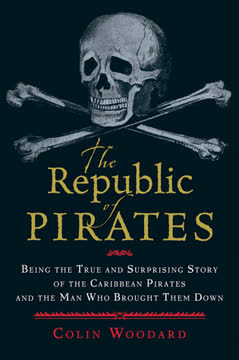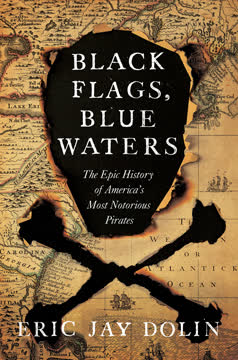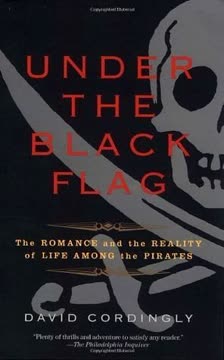Key Takeaways
1. Brutal Conditions at Sea Fueled Piracy.
Sailors stood below even farm laborers in England’s pecking order.
Life was perilous. Sailors faced extreme hazards, from crushing cargo and falls from rigging to rampant disease and starvation due to greedy owners. Mortality rates were shockingly high, comparable to those of enslaved Africans on transatlantic voyages.
Abuse was common. Captains ruled with absolute authority, often inflicting brutal punishments for minor infractions, sometimes resulting in death. Unlike the navy, merchant captains were only supposed to use "moderate" discipline, but many were sadists who faced little consequence.
Poor pay, no security. Sailors were often cheated out of their wages through various ruses, leaving their families destitute. The Royal Navy's press gangs violently kidnapped men, forcing them into service with even worse pay and discipline, making a life at sea seem little better than imprisonment.
2. Henry Avery's Legend Inspired a Generation of Outlaws.
To abused young sailors and cabin boys, Avery had become a hero.
Mutiny for freedom. Henry Avery, a seasoned sailor, led a mutiny aboard the Charles II in 1694 after merchants and officers betrayed the crew, effectively selling them into Spanish service. He offered his men a democratic alternative: sail to the Indian Ocean, plunder rich ships, and share the spoils equally.
A Robin Hood image. Avery's success, particularly the capture of the Grand Moghul's treasure ship, became legendary, amplified by sensationalized books and plays. Despite accounts of violence, the popular image portrayed him as a maritime Robin Hood who rose from oppression to create a pirate kingdom, inspiring future sailors.
The myth's power. The romanticized tales of Avery's wealth and freedom created a powerful myth that fueled the imaginations of young men like Bellamy, Blackbeard, and Vane. This legend, rather than following the Golden Age, helped to create it by offering a compelling alternative to the harsh realities of legitimate maritime life.
3. The Bahamas Became a Lawless Pirate Republic.
The Bahamas, every Jamaican knew, was a perfect buccaneering base.
Post-war vacuum. After the War of Spanish Succession ended in 1713, thousands of sailors were jobless, and Spanish guardas costas continued to harass English shipping. Benjamin Hornigold, a former privateer, saw the abandoned British colony of the Bahamas as an ideal sanctuary.
Nassau's ruins. Nassau, the capital, had been repeatedly sacked and left in ruins, devoid of effective government or naval presence. Hornigold and his small band found a perfect base to raid Spanish ships and plantations, selling their plunder to local merchants.
A growing haven. Word spread of the lawless haven, attracting unemployed seamen, runaway slaves, criminals, and disaffected colonists. Nassau transformed into a bustling pirate encampment, a "Flying Gang" that openly defied authority and threatened surrounding colonies.
4. Pirate Ships Operated Under Democratic Rule.
They ran their ships democratically, electing and deposing their captains by popular vote, sharing plunder equally, and making important decisions in an open council—all in sharp contrast to the dictatorial regimes in place aboard other ships.
A social contract. Unlike the hierarchical and brutal structure of merchant and naval vessels, pirate ships adopted a radical form of self-governance. Crews elected their captains, who held absolute authority only during combat.
Shared power and wealth. Key decisions were made by a vote of the entire crew in a general council. A quartermaster was elected to ensure fair distribution of food, supplies, and plunder, with captains typically receiving only slightly more shares than ordinary seamen.
Benefits and rules. Pirate articles often included provisions for disability compensation for injuries sustained in battle. While democratic, these societies had strict rules against theft from the company, desertion in battle, and other offenses, enforced by the crew.
5. Key Pirate Captains Forged Alliances and Rivalries.
Virtually all of the commodores knew one another, having served side by side aboard merchant or pirate vessels or crossed paths in their shared base, the failed British colony of the Bahamas.
From privateers to pirates. Many prominent pirates, including Hornigold, Jennings, Thatch (Blackbeard), and Vane, honed their skills as privateers during the War of Spanish Succession. The end of the war and lack of employment pushed them towards outright piracy.
Nassau's leaders. Hornigold was an early leader, but others like Henry Jennings, a more established figure, also operated out of Nassau, sometimes clashing over methods and plunder. Samuel Bellamy and Paulsgrave Williams, arriving later, quickly rose through the ranks due to their success and leadership.
Interconnected network. These captains formed a loose network, often sailing together, sharing information, and recruiting from the same pool of disaffected sailors. Their interconnectedness, forged in the shared space of Nassau and the privateering wars, was a key factor in the rapid growth of the pirate republic.
6. Pirates Severely Disrupted Transatlantic Trade.
At their zenith they succeeded in severing Britain, France, and Spain from their New World empires, cutting off trade routes, stifling the supply of slaves to the sugar plantations of America and the West Indies, and disrupting the flow of information between the continents.
Crippling commerce. The pirates' activities, particularly in the Caribbean and off the North American coast, brought transatlantic trade to a near standstill. They targeted valuable cargo ships, including those carrying slaves, sugar, tobacco, and manufactured goods.
Fear on the seas. The sheer number and audacity of pirate attacks made sea travel incredibly risky. Merchant captains often surrendered without a fight when confronted by pirate vessels, which were often faster and better manned than their own.
Colonial vulnerability. Colonies, particularly those in the West Indies and on the southern North American coast, were highly dependent on sea lanes for supplies and communication. Pirate blockades and raids caused economic hardship and instilled widespread fear among the populace.
7. Woodes Rogers Led the Crown's Counter-Piracy Effort.
More than anyone else, Rogers put an end to the Golden Age of Piracy.
A celebrated privateer. Woodes Rogers, a successful privateer and circumnavigator, was chosen by the British Crown to suppress the pirates and re-establish government in the Bahamas. Despite his own financial struggles, he accepted the unpaid position of governor.
Carrot and stick. Rogers's strategy involved offering a royal pardon to pirates who surrendered by a certain date, combined with a military force to hunt down those who refused. He believed many pirates, like those he encountered in Madagascar, would welcome a return to legitimacy.
A public-private venture. Rogers formed a corporation with investors to fund the expedition, providing soldiers, colonists, and supplies, while the Crown provided naval support and the authority of his commission. This ambitious plan aimed to transform the pirate haven into a productive colony.
8. The King's Pardon Divided the Pirate Ranks.
Every one of the nearly 400 men in Blackbeard’s flotilla had thought they’d taken an irrevocable step into criminality and rebellion, only to discover a possibility of a second chance.
An offer of clemency. King George I's proclamation in 1717 offered a full pardon to pirates who surrendered by a deadline, hoping to reduce their numbers without costly military action. This news reached the Bahamas in early 1718, causing immediate division.
Factions emerge. Pirates split into pro-pardon and anti-pardon camps. Leaders like Henry Jennings and Benjamin Hornigold, seeing an opportunity for legitimacy, embraced the pardon. Others, including Charles Vane and those with Jacobite sympathies, saw it as a threat to their freedom and rebellion.
Scattering and surrender. The pardon led to a mass exodus from Nassau, with hundreds of pirates surrendering in various colonies or scattering to new hideouts. While many took the pardon, a core group of hardliners remained, determined to resist the re-establishment of Crown authority.
9. Charles Vane Defied the Crown in Nassau.
He swore [that] while he was in the harbor, he would suffer no other Governor than himself.
Resistance leader. Charles Vane emerged as the outspoken leader of the anti-pardon faction in Nassau, tearing down the Union Jack and raising the black flag over the fort. He openly defied Captain Pearse of HMS Phoenix, who arrived to deliver the pardon.
Audacious acts. Vane's defiance included capturing vessels within sight of the Phoenix and even sending a fireship to attack the naval vessels. His actions, though ultimately unsuccessful in driving off the navy permanently, boosted the morale of the remaining pirates.
Last stand in Nassau. When Woodes Rogers arrived with his fleet, Vane, trapped in the harbor, chose a daring escape rather than surrender. He sailed out the narrow eastern channel, leaving Rogers to take control of the pirate-infested port.
10. Blackbeard Terrorized the Coasts with Calculated Fear.
So adorned, a contemporary biographer reported, “his eyes naturally looking fierce and wild, [that he] made altogether such a figure that imagination cannot form an idea of a fury from Hell to look more frightful.”
A fearsome image. Edward Thatch, known as Blackbeard, cultivated a terrifying appearance, tying lit fuses into his beard and carrying multiple pistols. This image was a strategic tool, often causing ships to surrender without a fight, preserving his crew and vessel.
Rise to prominence. After Bellamy's death, Blackbeard became one of the most powerful pirates, capturing the French slaver La Concorde and renaming her Queen Anne's Revenge. He commanded a large fleet and terrorized shipping from the Caribbean to the North American coast.
Calculated moves. Despite his fearsome reputation, Blackbeard often avoided unnecessary violence, preferring to use intimidation. He also sought alliances, briefly joining forces with Vane, and later attempted to establish a semi-legitimate base in North Carolina through collusion with corrupt officials.
11. Stede Bonnet's Gentleman Piracy Failed.
The Major was no sailor... and therefore [was] obliged to yield to many things that were imposed on him... for want of competent knowledge in maritime affairs.
Unlikely pirate. Stede Bonnet, a wealthy Barbadian planter, abandoned his family and comfortable life to become a pirate, despite having no sailing experience. He bought and outfitted his own sloop, the Revenge, and hired a crew.
Incompetent command. Bonnet proved to be a poor leader and tactician, suffering heavy losses in ill-advised battles and losing control of his crew. His men eventually deposed him, placing him under house arrest aboard Blackbeard's ship.
Capture and execution. After being double-crossed by Blackbeard, Bonnet attempted to resume piracy but was eventually captured by colonial forces off North Carolina. Despite his social standing and pleas for mercy, he was tried and hanged in Charleston.
12. Rogers Restored Order, Marking the End of the Golden Age.
With the execution of Rackham and Vane, the Golden Age of Piracy was all but over.
Re-establishing authority. Woodes Rogers faced immense challenges in Nassau, including disease, lazy inhabitants, and threats from Vane and the Spanish. He used a combination of force, pardons, and political maneuvering to gradually assert control.
Trials and executions. Rogers held trials for captured pirates, executing those who refused the pardon or committed crimes after accepting it. These public hangings, though few in number compared to the total pirate population, sent a clear message that the era of lawlessness was ending.
Decline of piracy. By 1725, the number of active pirates had drastically declined due to successful counter-piracy efforts, pardons, and the loss of key leaders and bases like Nassau. While piracy continued in some regions, the organized, large-scale threat to transatlantic trade that characterized the Golden Age was effectively over.
Last updated:
FAQ
What is The Republic of Pirates by Colin Woodard about?
- Comprehensive history of piracy: The book chronicles the rise and fall of Caribbean pirates during the early 18th century, focusing on the so-called "Golden Age of Piracy" (1715–1725).
- Key figures and events: It centers on notorious pirates like Blackbeard, Charles Vane, Samuel Bellamy, Stede Bonnet, and the pirate hunter Woodes Rogers, detailing their exploits and ultimate downfall.
- Pirate republic in the Bahamas: Woodard explores how pirates established a de facto republic in Nassau, creating a unique society with its own rules and governance.
- Broader historical context: The narrative situates piracy within the era’s geopolitical struggles, including colonial rivalries, the War of Spanish Succession, and the influence of Jacobite sympathies.
Why should I read The Republic of Pirates by Colin Woodard?
- Debunks pirate myths: The book separates fact from fiction, challenging romanticized and villainous stereotypes by presenting pirates as complex, often politically motivated figures.
- Insight into pirate democracy: Woodard reveals how pirates practiced early forms of democracy, equality, and social welfare, contrasting sharply with the authoritarian regimes of their time.
- Rich historical research: The narrative is grounded in extensive archival research, including trial records, letters, and contemporary accounts, offering a vivid and accurate portrayal of pirate life.
- Broader impact on history: The book demonstrates how piracy influenced colonial societies, trade, and even the development of democratic ideas leading up to the American Revolution.
What are the key takeaways from The Republic of Pirates by Colin Woodard?
- Piracy as rebellion: Pirates were not just criminals but rebels against oppressive maritime and colonial systems, seeking freedom and equality.
- Pirate society’s uniqueness: The pirate republic in Nassau was a multicultural, democratic society that challenged the norms of the era.
- Suppression and legacy: The British Crown’s campaign, led by Woodes Rogers, ultimately dismantled the pirate stronghold, but the pirates’ influence persisted in culture and politics.
- Complex motivations: Pirates were driven by a mix of economic necessity, political ideology (including Jacobite sympathies), and a desire for autonomy.
Who were the main figures in The Republic of Pirates by Colin Woodard, and why are they important?
- Blackbeard (Edward Thatch): Known for his fearsome image and strategic mind, he commanded the Queen Anne’s Revenge and became the most infamous pirate of the era.
- Charles Vane: A ruthless leader who rejected royal pardons and led violent resistance against colonial authorities, ultimately captured and executed.
- Samuel “Black Sam” Bellamy: Celebrated for his egalitarian leadership and political rhetoric, he rose quickly to power before dying in the Whydah shipwreck.
- Stede Bonnet: The “Gentleman Pirate,” whose unlikely background and partnership with Blackbeard highlight the diversity within pirate ranks.
- Woodes Rogers: The British governor whose military and political campaign ended the pirate republic and restored colonial order in the Bahamas.
How did the pirate republic in Nassau, Bahamas, function according to The Republic of Pirates?
- Self-governance and democracy: Pirates established councils, elected officers, and created codes of conduct, fostering a sense of order and equality.
- Multicultural society: The community included whites, blacks, mulattoes, runaway slaves, and forced men, united by shared values and mutual aid.
- Economic activities: Pirates plundered ships, traded with merchants, and invested in local property, creating a thriving local economy.
- Internal divisions: The society was split between those willing to accept royal pardons and die-hard rebels, leading to instability and eventual collapse.
What were the social and political motivations of pirates during the Golden Age, as described in The Republic of Pirates?
- Rebellion against oppression: Pirates saw themselves as resisting harsh naval discipline, economic inequality, and colonial authority.
- Jacobite sympathies: Many pirates supported the Stuart pretenders, opposing the Hanoverian kings and aligning themselves with broader political causes.
- Democratic ideals: Pirates practiced equality and self-governance aboard their ships, attracting diverse crews and challenging social hierarchies.
- Economic survival: For many, piracy was a response to unemployment, poverty, and the brutal conditions of merchant and naval service.
How did the British government and Royal Navy respond to piracy during the Golden Age, according to The Republic of Pirates?
- Initial neglect and challenges: Limited naval resources and local complicity allowed piracy to flourish in the Caribbean and American colonies.
- Royal Proclamation of Pardon (1717): King George I offered pardons to pirates willing to surrender, aiming to reduce their numbers through legal means.
- Military campaigns: The government authorized expeditions, such as Woodes Rogers’s mission to the Bahamas and Alexander Spotswood’s operation in North Carolina, to forcibly suppress piracy.
- Legal and political complexities: Efforts to prosecute pirates were hampered by jurisdictional issues, local sympathies, and the pirates’ political affiliations.
What role did colonial governors and officials play in the events described in The Republic of Pirates by Colin Woodard?
- Complicity and corruption: Some officials, like North Carolina’s Governor Charles Eden, colluded with pirates, accepting bribes and facilitating their activities.
- Active suppression: Others, such as Woodes Rogers and Alexander Spotswood, led campaigns to capture and prosecute pirates, restoring colonial order.
- Political intrigue: The book highlights the complex interplay of personal rivalries, imperial interests, and local politics that shaped the response to piracy.
- Legal ambiguity: Governors sometimes acted without clear legal authority, blurring the lines between law enforcement and personal ambition.
How did the War of Spanish Succession and the 1715 Spanish treasure fleet wreck influence piracy in The Republic of Pirates?
- Surge in privateering: The war created a pool of experienced sailors who turned to piracy when peace ended their legal commissions.
- Economic hardship: Post-war unemployment and reduced wages pushed many seamen toward piracy as a means of survival.
- Treasure fleet wreck as catalyst: The 1715 hurricane that destroyed the Spanish fleet scattered treasure along the Florida coast, attracting pirates and escalating their activities.
- Increased conflict: The competition for treasure led to alliances, betrayals, and violent confrontations among pirate factions and colonial authorities.
What were the daily life and working conditions like for pirates and sailors in The Republic of Pirates?
- Harsh environment: Life at sea was dangerous, with risks from disease, starvation, and brutal discipline, both for pirates and regular sailors.
- Pirate democracy: Pirates elected their leaders, shared plunder equally, and provided social protections like disability benefits, contrasting with the authoritarian regimes of merchant and naval ships.
- Diverse crews: Pirate ships were ethnically and socially diverse, including whites, blacks, mulattoes, and indigenous peoples.
- Cultural practices: Pirates engaged in rituals, distinctive dress, and camaraderie, contributing to their legendary image and group cohesion.
How did Woodes Rogers suppress the pirate republic in Nassau, according to The Republic of Pirates?
- Strategic leadership: Rogers combined military force, diplomacy, and offers of royal pardon to entice pirates to surrender and restore order.
- Rebuilding and governance: He rebuilt Nassau’s defenses, established a governing council, and formed alliances with merchants and moderate pirates.
- Overcoming resistance: Rogers faced opposition from die-hard pirates like Charles Vane, as well as threats from disease and Spanish invasion.
- Long-term impact: His campaign marked the end of the pirate stronghold, leading to the capture and execution of major pirates and the reestablishment of British colonial authority.
What are the best quotes from The Republic of Pirates by Colin Woodard, and what do they mean?
- Blackbeard’s final words: “Damn you villains, who are you and from whence came you?” captures the defiance and drama of pirate confrontations with naval forces.
- Benjamin Franklin’s sailor’s song: “It’s better to swim in the sea below / Than to swing in the air and feed the crow, / Says jolly Ned Teach of Bristol,” reflects the risks and fatalism of pirate life.
- Woodes Rogers’s motto: “DUM SPIRO SPERO” (“While I breathe, I hope”) symbolizes Rogers’s perseverance in the face of adversity and his role in suppressing piracy.
- On pirate executions: The book’s accounts of public hangings and their impact on society highlight the grim reality behind the pirate legend and the ultimate fate of many pirates.
Review Summary
The Republic of Pirates receives mixed reviews, with many praising its detailed historical account of Caribbean piracy's golden age. Readers appreciate the well-researched portrayal of famous pirates like Blackbeard and Charles Vane, as well as the political context of the era. Some find the book engaging and informative, while others criticize it for being dry and overly focused on technical details. Several reviewers note that the book doesn't fully explore the concept of a pirate republic as suggested by the title. Overall, it's recommended for those interested in pirate history.
Similar Books
Download PDF
Download EPUB
.epub digital book format is ideal for reading ebooks on phones, tablets, and e-readers.








